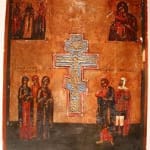Crucifixion with Enameled Brass Cross, 18th Century CE - 19th Century CE
Paint on Wood Panel
17.5
PF.5705
Further images
Russians inherited the tradition of icon painting from Byzantium, where it began as an offshoot of the mosaic and fresco tradition. During the 8th and 9th centuries, the iconoclastic controversy...
Russians inherited the tradition of icon painting from Byzantium, where it began as an offshoot of the mosaic and fresco tradition. During the 8th and 9th centuries, the iconoclastic controversy in the Orthodox Church called into question whether religious images were a legitimate practice or sacrilegious idolatry. Although the use of images was in the end permitted, a thorough distinction between profane art intended to depict reality and sacred art designed for spiritual contemplation was established. Certain kinds of balance and harmony became established as reflections of divinity, and as such they invited careful reproduction and subtle refinement rather than striking novelty. Although this philosophy resulted in a comparatively slow evolution of style, icon painting evolved considerably over the centuries. Unlike the pictorial traditions of the west that aspire towards increased realism and naturalism, the essence of Russian icon painting is not about the representation of physical space or appearance. Icons are images intended to aid in contemplative prayer, and in that sense, are more concerned with conveying meditative harmony than with laying out a realistic scene.
The light reflects off the gold leaf decorating this stunning icon as if illuminated by the light of heaven. The focus of the composition is a large enameled brass crucifix that has been fitted into the wood panel. The detailed casting of the brass is extraordinary. God rules from above flanked by two angels. A skull, supposedly the very skull of Adam, the first man, lies at the base of the cross. The amount of detail fitted into such a small space is extraordinary. However, much the same could be said about the painting. On the upper corners, a representation of three saints appears on the left and the Mother of God is shown on the right, as if smaller icons that have been hung onto the golden background. Below, a series of saints stand faithfully by, witnessing the sacrifice of their lord. Clearly the focus of this icon is on the spectacular brass Crucifixion. The surrounding saints pay reverence to this event much as we the viewer kneels before the icon in awe.
The light reflects off the gold leaf decorating this stunning icon as if illuminated by the light of heaven. The focus of the composition is a large enameled brass crucifix that has been fitted into the wood panel. The detailed casting of the brass is extraordinary. God rules from above flanked by two angels. A skull, supposedly the very skull of Adam, the first man, lies at the base of the cross. The amount of detail fitted into such a small space is extraordinary. However, much the same could be said about the painting. On the upper corners, a representation of three saints appears on the left and the Mother of God is shown on the right, as if smaller icons that have been hung onto the golden background. Below, a series of saints stand faithfully by, witnessing the sacrifice of their lord. Clearly the focus of this icon is on the spectacular brass Crucifixion. The surrounding saints pay reverence to this event much as we the viewer kneels before the icon in awe.







